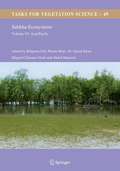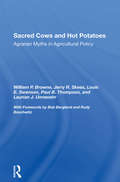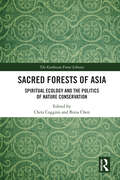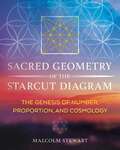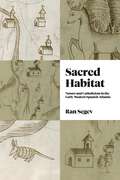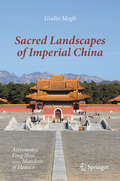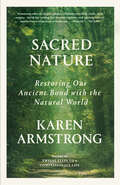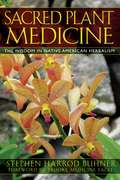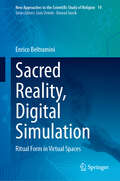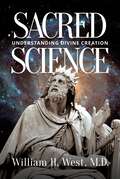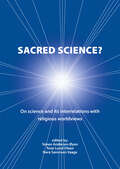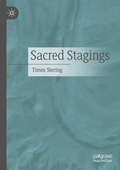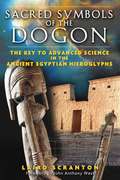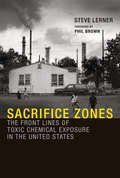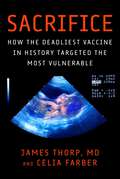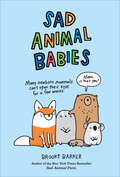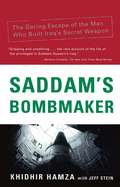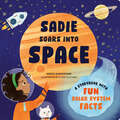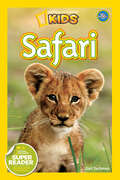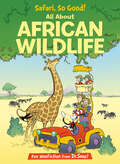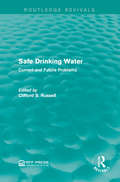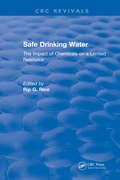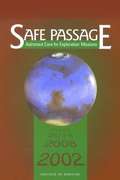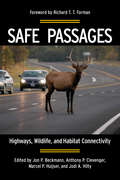- Table View
- List View
Sabkha Ecosystems: Volume VI: Asia/Pacific (Tasks for Vegetation Science #49)
by Benno Böer M. Ajmal Khan Miguel Clüsener-Godt Bilquees Gul Abdul HameedThis book is the sixth and final volume in the Tasks for Vegetation Science book series, and it concludes the most comprehensive scientific documentation dealing with hypersaline ecosystems of the world.
Sacred Cows And Hot Potatoes: Agrarian Myths And Agricultural Policy
by Paul Thompson William P. Browne Jerry R Skees Louis E SwansonSacred Cows and Hot Potatoes challenges many of the assumptions of current agricultural policies—such as equating "farm" with "rural," high farm prices with high farm incomes, or farm programs with food programs—and examines the agrarian roots of these policies. From the origins of agrarian myths to the latest controversies over farming and the environment, this book provides an overview of the use and abuse of agrarian values in policymaking. Illustrated with pictures, cartoons, and graphs, the book will appeal to a broad audience, including policymakers, rural sociologists, agricultural economists, political scientists, ethicists, and the interested public.
Sacred Forests of Asia: Spiritual Ecology and the Politics of Nature Conservation (The Earthscan Forest Library)
by Chris Coggins Bixia ChenPresenting a thorough examination of the sacred forests of Asia, this volume engages with dynamic new scholarly dialogues on the nature of sacred space, place, landscape, and ecology in the context of the sharply contested ideas of the Anthropocene. Given the vast geographic range of sacred groves in Asia, this volume discusses the diversity of associated cosmologies, ecologies, traditional local resource management practices, and environmental governance systems developed during the pre-colonial, colonial, and post-colonial periods. Adopting theoretical perspectives from political ecology, the book views ecology and polity as constitutive elements interacting within local, regional, and global networks. Readers will find the very first systematic comparative analysis of sacred forests that include the karchall mabhuy of the Katu people of Central Vietnam, the leuweng kolot of the Baduy people of West Java, the fengshui forests of southern China, the groves to the goddess Sarna Mata worshiped by the Oraon people of Jharkhand India, the mauelsoop and bibosoop of Korea, and many more. Comprising in-depth, field-based case studies, each chapter shows how the forest’s sacrality must not be conceptually delinked from its roles in common property regimes, resource security, spiritual matters of ultimate concern, and cultural identity. This volume will be of great interest to students and scholars of indigenous studies, environmental anthropology, political ecology, geography, religion and heritage, nature conservation, environmental protection, and Asian studies.
Sacred Geometry of the Starcut Diagram: The Genesis of Number, Proportion, and Cosmology
by Malcolm Stewart• Lavishly illustrated with hundreds of detailed diagrams and technical illustrations exploring the evolution and importance of the starcut diagram • Shows how the starcut diagram underlies the shaman&’s dance in China, the Vedic Fire Altar in India, Raphael frescoes, labyrinth designs, the Great Pyramid in Egypt, and the building of ancient cities • Explains how the starcut diagram was used in building and design, how it relates to Pythagoras&’s Tetrakys, and how it contains knowledge of the Tree of Life As Malcolm Stewart reveals in this lavishly illustrated study, the simplesquare figure of the Starcut diagram, created only with circles, has extraordinary geometric properties. It allows you to make mathematically exact measurements and build perfectly true level structures without a computer, calculator, slide rule, plumb bob, or laser level. Sharing his extensive research, along with hundreds of detailed diagrams and technical illustrations, the author shows how the Starcut diagram was the key to the building of humanity&’s first cities and how it underlies many significant patterns and proportions around the world. Using circles drawn from the vesica piscis, Stewart explains how to create the Starcut diagram and shows how this shape was at the foundation of ancient building and design, illustrating the numerous connections between the diagram and the creation of mandalas and yantras, stained glass windows, architectural ground plans, temples and other sacred buildings, and surveying methods. He also shows how the Starcut diagram reveals ancient geometric knowledge of pi, the Fibonacci sequence, Pythagorean shapes and seals, the golden ratio, the power of 108 and other sacred numbers, and magic squares. Exploring the Starcut diagram&’s cosmological and theological implications, Stewart explains how it contains knowledge of the Tree of Life and the Kabbalah. He examines how it relates to the Tetraktys, the key teaching device of Pythagoras, and other cosmograms. Demonstrating the ancient relationships existing between number, geometry, cosmology, and musical harmony, the author shows how the simple shape of the Starcut diagram unifies the many threads of sacred geometry into one beautiful mathematical tapestry.
Sacred Habitat: Nature and Catholicism in the Early Modern Spanish Atlantic (Iberian Encounter and Exchange, 475–1755)
by Ran SegevKnown as a time of revolutions in science, the early modern era in Europe was characterized by the emergence of new disciplines and ways of thinking. Taking this conceit a step further, Sacred Habitat shows how Spanish friars and missionaries used new scholarly approaches, methods, and empirical data from their studies of ecology to promote Catholic goals and incorporate American nature into centuries-old church traditions.Ran Segev examines the interrelated connections between Catholicism and geography, cosmography, and natural history—fields of study that gained particular prominence during the sixteenth and seventeenth centuries—and shows how these new bodies of knowledge provided innovative ways of conceptualizing and transmitting religious ideologies in the post-Reformation era. Weaving together historical narratives on Spain and its colonies with scholarship on the Catholic Reformation, Atlantic science, and environmental history, Segev contends that knowledge about American nature allowed pious Catholics to reconnect with their religious traditions and enabled them to apply their beliefs to a foreign land.Sacred Habitat presents a fresh perspective on Catholic renewal. Scholars of religion and historians of Spain, colonial Latin America, and early modern science will welcome this provocative intervention in the history of empire, science, knowledge, and early modern Catholicism.
Sacred Landscapes of Imperial China: Astronomy, Feng Shui, and the Mandate of Heaven
by Giulio MagliThis book analyses the magnificent imperial necropolises of ancient China from the perspective of Archaeoastronomy, a science which takes into account the landscape in which ancient monuments are placed, focusing especially but not exclusively on the celestial aspects. The power of the Chinese emperors was based on the so-called Mandate of Heaven: the rulers were believed to act as intermediaries between the sky gods and the Earth, and consequently, the architecture of their tombs, starting from the world-famous mausoleum of the first emperor, was closely linked to the celestial cycles and to the cosmos. This relationship, however, also had to take into account various other factors and doctrines, first the Zhao-Mu doctrine in the Han period and later the various forms of Feng Shui. As a result, over the centuries, diverse sacred landscapes were constructed. Among the sites analysed in the book are the “pyramids” of Xi’an from the Han dynasty, the mountain tombs of the Tang dynasty, and the Ming and Qing imperial tombs. The book explains how considerations such as astronomical orientation and topographical orientation according to the principles of Feng Shui played a fundamental role at these sites.
Sacred Nature: Restoring Our Ancient Bond with the Natural World
by Karen ArmstrongFrom one of the most original thinkers on the role of religion in the modern world, a profound exploration of the spiritual power of nature—and an urgent call to reclaim that power in everyday life. "Much has been written on the scientific and technological aspects of climate change.... But Armstrong&’s book is both more personal and more profound. Its urgent message is that hearts and minds need to change if we are to once more learn to revere our beautiful and fragile planet." —The GuardianSince the beginning of time, humankind has looked upon nature and seen the divine. In the writings of the great thinkers across religions, the natural world inspires everything from fear, to awe, to tranquil contemplation; God, or however one defined the sublime, was present in everything. Yet today, even as we admire a tree or take in a striking landscape, we rarely see nature as sacred.In this short but deeply powerful book, the best-selling historian of religion Karen Armstrong re-sacralizes nature for modern times. Drawing on her vast knowledge of the world&’s religious traditions, she vividly describes nature&’s central place in spirituality across the centuries. In bringing this age-old wisdom to life, Armstrong shows modern readers how to rediscover nature&’s potency and form a connection to something greater than ourselves.
Sacred Plant Medicine: The Wisdom in Native American Herbalism
by Brooke Medicine Eagle Stephen Harrod BuhnerThe first in-depth examination of the sacred underpinnings of the world of Native American medicinal herbalism• Reveals how shamans and healers “talk” with plants to discover their medicinal properties• Includes the prayers and medicine songs associated with each of the plants examined• By the author of The Secret Teachings of PlantsAs humans evolved on Earth they used plants for everything imaginable--food, weapons, baskets, clothes, shelter, and medicine. Indigenous peoples the world over have been able to gather knowledge of plant uses by communicating directly with plants and honoring the sacred relationship between themselves and the plant world. In Sacred Plant Medicine Stephen Harrod Buhner looks at the long-standing relationship between indigenous peoples and plants and examines the techniques and states of mind these cultures use to communicate with the plant world. He explores the sacred dimension of plant and human interactions and the territory where plants are an expression of Spirit. For each healing plant described in the book, Buhner presents medicinal uses, preparatory guidelines, and ceremonial elements such as prayers and medicine songs associated with its use.
Sacred Reality, Digital Simulation: Ritual Form in Virtual Spaces (New Approaches to the Scientific Study of Religion #19)
by Enrico BeltraminiThis study explores the relationship between the sacred and the virtual, emphasizing the sacred as a divinely dependent, consecrated space activated through ritual, mediating between the profane and the holy. The central argument is that the virtual is fundamentally incompatible with the ritual form—a concept developed by Romano Guardini and others, including Joseph Ratzinger—which holds that the sacred is not merely acknowledged but made present through ritualized actions that require tangible, participatory engagement. Even if the virtual realm were acknowledged as real and retained both the bodily presence of the faithful and the Divine Presence, the rite would still be ineffective. Virtuality prevents the proper enactment of the rite, rendering it ineffective. At its core, the ritual form is performative, embodied, and consecratory. It requires physical presence, material elements, and a structured sequence of gestures, symbols, and words that together make the divine encounter possible. Their absence in virtual spaces disrupts ritual form, compromising its sacramental function.
Sacred Science: Understanding Divine Creation
by William H. WestIf you review of the impulses that created the universe, directed the unfolding of life, and empowered human consciousness you reach an undeniable conclusion: an omnipotent Creator supervised the unfolding of our universe.From the moment of creation to the emergence of a planet tailor-made for life, from the journey of multi-million species to the development of an upright creature hungry for God, science tells a sacred story: a superintelligent Creator used His mathematical genius to convert lifeless equations into galaxies, planets, and people. His love has been visible throughout the process. Could our journey reflect thousands of random accidents with no divine guidance? Creation delivered impulses that filled the universe with galaxies and stars. Eliminate any one of those blueprints and the universe would have been stillborn. Stars produced a perfect mix of elements to bring the universe to life. Without a robust ensemble of gene and protein sequences, life might still be living at the bottom of the sea. Hundreds of human genes convert the neurons of a human infant into trillions of networks in an adult brain. Without those God-given genes, a dangerous world may have left us trapped in the treetops with no interest in science at all. But God shared His mind and triggered the emergence of human consciousness. Where do we find ourselves after centuries of that scientific searching? We see that science reflets its source. Science is a gift of God&’s creative love, and is nothing less than sacred!
Sacred Science?
by Tone Lund-Olsen Simen Andersen Øyen Nora Sørensen VaageScience and religion are often viewed as dichotomies. But although our contemporary society is often perceived as a rationalization process, we still need broad, metaphysical beliefs outside of what can be proven empirically. Rituals and symbols remain at the core of modern life. Do our concepts of science and religion require revitalization? Can science itself be considered a religion, a belief, or an ideology? Science's authority and prestige allows for little in the way of alternate approaches not founded in empirical science. It is not unusual to believe that technology and science will solve the world's fundamental problems. Has truth been colonized by science? Have scientific disciplines become so specialized and "operationally closed" that they have constructed barriers to other disciplines as well as the general public? The writers of this book set out to investigate whether the symbols of academia may in some cases take on a quality of sacrality, whether the rule of experts can be said to have the character of a "priesthood of knowledge", whether religion has a place in scientific contexts, and a selection of other questions concerning science and its relations to religious belief.
Sacred Stagings
by Timm SieringLiturgical acts can be understood as performances. In this context, the focus is on the specific stagings within the diverse landscape of worship services, prompting an analysis that primarily explores the hermeneutics of individual liturgical practices and artifacts. The understanding of worship in this work is not primarily derived from a semiotic interpretation of worship based on theater theories. Rather, it becomes evident that worship services unfold their character as a cultural practice sui generis especially where they fundamentally differ from theater by presenting themselves as something other than everyday life. Guided by a concept of performativity developed primarily in religious education, a distinction is made between the factual and tactical design of liturgical processes. Following some terminological considerations, this is first illustrated using the example of the entrance rite. Here, the intentions and effects of individual traditional formulations and their situational adaptations are compared. Finally, three case studies focus on musical and pop-cultural approaches to an understanding of worship that, when thought of from the perspective of music, can be described as &“liturgicking.&”
Sacred Symbols of the Dogon: The Key to Advanced Science in the Ancient Egyptian Hieroglyphs
by John Anthony West Laird ScrantonDogon cosmology provides a new Rosetta stone for reinterpreting Egyptian hieroglyphs • Provides a new understanding of Egyptian hieroglyphs as scientific symbols based on Dogon cosmological drawings • Use parallels between Dogon and Egyptian word meanings to identify relationships between Dogon myths and modern science In The Science of the Dogon, Laird Scranton demonstrated that the cosmological structure described in the myths and drawings of the Dogon runs parallel to modern science--atomic theory, quantum theory, and string theory--their drawings often taking the same form as accurate scientific diagrams that relate to the formation of matter. Scranton also pointed to the close resemblance between the keywords and component elements of Dogon cosmology and those of ancient Egypt, and the implication that ancient cosmology may also be about actual science.Sacred Symbols of the Dogon uses these parallels as the starting point for a new interpretation of the Egyptian hieroglyphic language. By substituting Dogon cosmological drawings for equivalent glyph-shapes in Egyptian words, a new way of reading and interpreting the Egyptian hieroglyphs emerges. Scranton shows how each hieroglyph constitutes an entire concept, and that their meanings are scientific in nature. Using the Dogon symbols as a “Rosetta stone,” he reveals references within the ancient Egyptian language that define the full range of scientific components of matter: from massless waves to the completed atom, even suggesting direct correlations to a fully realized unified field theory.
Sacrifice Zones: The Front Lines of Toxic Chemical Exposure in the United States (The\mit Press Ser.)
by Steve LernerThe stories of residents of low-income communities across the country who took action when pollution from heavy industry contaminated their towns.Across the United States, thousands of people, most of them in low-income or minority communities, live next to heavily polluting industrial sites. Many of them reach a point at which they say “Enough is enough.” After living for years with poisoned air and water, contaminated soil, and pollution-related health problems, they start to take action—organizing, speaking up, documenting the effects of pollution on their neighborhoods.In Sacrifice Zones, Steve Lerner tells the stories of twelve communities, from Brooklyn to Pensacola, that rose up to fight the industries and military bases causing disproportionately high levels of chemical pollution. He calls these low-income neighborhoods “sacrifice zones.” And he argues that residents of these sacrifice zones, tainted with chemical pollutants, need additional regulatory protections.Sacrifice Zones goes beyond the disheartening statistics and gives us the voices of the residents themselves, offering compelling portraits of accidental activists who have become grassroots leaders in the struggle for environmental justice and details the successful tactics they have used on the fenceline with heavy industry.
Sacrifice: How the Deadliest Vaccine in History Targeted the Most Vulnerable
by Celia Farber James ThorpSacrifice documents the true story of Dr. James Thorp, a respected doctor of maternal fetal medicine, who in 2020, finds his entire profession has lost its mind, as well as its soul. Stunned to find his colleagues take the bribe money, drink the Kool-Aid, and push the COVID-19 shots, Thorp is one of the few Ob-Gyns to bear witness and broadcast the multitude of pregnancy complications including miscarriages, stillbirths, and many other tragic outcomes resulting from the shots. One of the few doctors from the maternal-fetal medicine realm who publicly protested the Covid shots as directly deadly to his patients—unborn babies—Thorp witnessed the carnage on a daily basis firsthand, documented it, published papers, and spoke up on countless media platforms, and in Senate hearings in Washington, DC. He was terminated, without any cause, and went on to campaign around the country to get the truth out. This is his story.
Sad Animal Babies
by Brooke BarkerA new collection of cartoons and science trivia by the New York Times–bestselling author, explaining why life is tough for little creatures in the wild . . . No one ever said it was easy being young, and it&’s especially true if you&’re a little creature out in the jungles, forests, deserts, and oceans of the big, bad world. Following on the success of her Instagram feed and first book, Sad Animal Facts, Brooke Barker continues her examination of the various foibles and pitfalls of the zoological world, focusing on its fledgling members this time around. Featuring more than 100 entries, the book is organized into the categories of Mammals, Birds, Reptiles, Amphibians, Insects & Miscellaneous Invertebrates, Marsupials, Fish, and Aquatic Mammals. Every animal gets a hand-drawn image, an informative caption, and a wry quotation, and in the back, there&’s an appendix with further zoological details. Praise for Brooke Barker &“Witty comments and charmingly drawn illustrations.&” —Pittsburgh Post-Gazette
Saddam's Bombmaker
by Khidhir Hamza Jeff SteinThe Iraqi scientist who designed Baghdad's nuclear bomb tells how he did it in secret with the cynical help of U.S., French, German, and British suppliers and experts, and kept it hidden from U.N. inspectors after the Gulf War. Today, he says, Saddam Hussein is only months away from making a workable bomb and has every intention of using it. Don't tell me about the law. The law is anything I write on a scrap of paper." Saddam Hussein In 1994, after twenty years developing Iraq's atomic weapon, Dr. Khidhir Hamza made a daring escape to warn the CIA of Saddam's nuclear ambitions...only to be ridiculed and turned away! After a harrowing journey across three continents with Iraqi agents on his trail, Hamza finally came in from the cold at the U.S. embassy in Hungary. Now he tells a frightening story that U.S. officials have finally come to believe: that Saddam is still feverishly at work on the bomb and, if pushed to the wall, will use it. Dr. Hamza also presents a startling, unprecedented portrait of Saddam himself his drunken rages, his women, his fear of germs, and his cold-blooded murder of underlings. A former resident of the presidential palace, Hamza is the only defector who has lived to write a firsthand, intimate portrait of the Iraqi inner circle, its spies and hit men, and their brutal chief. Saddam's Bombmaker is also a saga of one man's journey through the circles of hell. Educated at MIT and Florida State University, dedicated to a life of peaceful teaching in America, Dr. Hamza relates how the regime ordered him home, seduced him into a pampered life as an atomic energy official, and forced him to design a bomb. The price of refusal was torture. As the father of the Iraqi bomb, Dr. Hamza designed a device from scratch with the help of World War Twoera blueprints from America's Los Alamos labs, all the while planning an escape. Privately, he and his colleagues believed they could procrastinate long enough to outlive Saddam. But the dictator outmaneuvered them, whipping the scientists into a crash program to build a crude bomb that could be dropped on Israel. Had U.S. and Allied forces not quickly mobilized for Desert Storm, Dr. Hamza relates, Saddam may well have succeeded; except for sufficient uranium, the device was ready. It still is. Dr. Hamza's tale of his escape, his first bungled contact with CIA agents, and his flight abroad will keep readers turning pages toward a climax worthy of a well-crafted spy thriller. Along the way, he reveals: The West's "don't ask, just sell" attitude toward Iraq's nuclear, chemical, and biological programs as long as it was fighting Iran. How Iraq tested biological and chemical weapons on human subjects. How the Palestinian Liberation Organization (PLO) tried to recruit Dr. Hamza to make a bomb. Baghdad's secret program to break into U.S. and other foreign computer systems. Saddam's Bombmaker is not only a shocking political and scientific exposé -- it is a riveting adventure tale.
Sadie Soars into Space (STEM Storybooks for Toddlers)
by Arezu Sarvestani3, 2, 1, blastoff! Learn all about planets, asteroids, stars, and more as you journey through the solar system with Sadie in this space storybook for toddlers.What are comets made of? Which planet is the hottest? Which one is the coldest? Join Sadie and her cat, Buckles, on a daring journey through the solar system to answer these questions and more. In this delightful tale, Sadie visits each planet, marveling at comets, asteroids, and more along the way. And with each stop, young readers are introduced to fascinating facts about outer space, sparking curiosity about the wide expanse of our universe. Sadie Soars into Space is an engaging and educational addition to any toddler&’s library. A constellation of STEM facts. There&’s nothing toddlers enjoy more than asking &“why?&” Here, your budding astronaut&’s questions are answered with scientific facts about our solar system. Whimsical story and engaging rhymes. The inquisitive Sadie and her adorable cat are sure to charm little ones who dream of space travel and love gazing up at the night sky. See the universe up close. Beautiful illustrations highlight the wonders of space in detail and full color. An out-of-this-world author. The only space book for kids written by a NASA science communicator.
Safari (Readers)
by Gail TuchmanSafari day dawns on the savanna. The African light gives the sky colors seen nowhere else on Earth. Soon, an amazing array of wild animals are yawning, screeching, and growling to life. Meet the elephants, lions, giraffes, zebras, hippos, and the laughing hyenas of the wilderness and find out who&’s friends with whom and why!National Geographic supports K-12 educators with ELA Common Core Resources.Visit www.natgeoed.org/commoncore for more information.
Safari, So Good! All About African Wildlife: All About African Wildlife (The Cat in the Hat's Learning Library)
by Bonnie WorthLaugh and learn with fun facts about lions, hippos, elephants, and more—all told in Dr. Seuss&’s beloved rhyming style and starring the Cat in the Hat! &“I&’m the Cat in the Hat. Pack your bag. Come with me. We&’re going to Africa on safari!&” The Cat in the Hat&’s Learning Library series combines beloved characters, engaging rhymes, and Seussian illustrations to introduce children to non-fiction topics from the real world! Journey on an African safari and discover: • why zebras sleep standing up• how baboons groom each other• why hippos spend so much time in the water• and much more! Perfect for story time and for the youngest readers, Safari, So Good! All About African Wildlife also includes an index, glossary, and suggestions for further learning. Look for more books in the Cat in the Hat&’s Learning Library series!If I Ran the Horse Show: All About HorsesClam-I-Am! All About the BeachMiles and Miles of Reptiles: All About ReptilesA Whale of a Tale! All About Porpoises, Dolphins, and WhalesThere's a Map on My Lap! All About MapsOh, the Lavas That Flow! All About VolcanoesOut of Sight Till Tonight! All About Nocturnal AnimalsWhat Cat Is That? All About CatsOnce upon a Mastodon: All About Prehistoric MammalsOh Say Can You Say What's the Weather Today? All About WeatherThe Cat on the Mat: All About Mindfulness
Safe Drinking Water: Current and Future Problems (Routledge Revivals)
by Clifford S. RussellOriginally published in 1978, this volume addresses the scientific, economic, and administrative aspects of the public policy problem raised by the United States’ Safe Drinking Water Act of 1974. In this collection of papers, the authors examine the various problems presented by drinking public water in the United States, the United Kingdom, and throughout Europe. This is an ideal title for students interested in environmental studies and public policy reform.
Safe Drinking Water: The Impact of Chemicals on a Limited Resource (CRC Press Revivals)
by Rip G. RiceA review of the nation’s new coverages serves as a ready reminder that drinking water safety is more than regional of local concern. In recent times, the print media alone has drawn attention to barium, bacteria, heavy metals, and increasingly organic contaminants, in public water supplies located in Florida, Rhode Island, Texas, Oregon, Illinois, Minnesota, North Carolina, Michigan, and California, to name a few. In an effort to address one of the major issues confronting the future of the nation’s drinking water supplies, chemical contamination, the Drinking Water Research Foundation and the American Chemical Society presented the symposium, "Safe Drinking Water: the Impact of Chemicals on a Limited Resource." To add balance to the total presentation, two papers were included that were not part of the symposium. Many questions as to the public significance of hundreds of organic chemicals known to be present in the national drinking water supply are waiting to be answered. In some areas of the country, aid rain-induced alterations of the natural leaching process represent an unexplored potential source of toxic pollutants. Finding workable ways to clean up the water supply will be an ongoing task. Addressing these questions, as well as investigating how other countries are responding to these problems, the alternate sources available, such as bottled water, and point of use devices, the presenters in this symposium have attempted to explain the problems, situation, and alternatives. As progress is made in one area, setbacks will occur in another. As we eliminate problems thought chemical technology, we often create others, such as contamination of our waters. While all the situations, problems, and alternatives are not discussed in these proceedings, it is hoped that some attention will be brought to the public, government, and private sectors so that future work will be done to assure the nation of safe drinking water resources.
Safe Laboratories: Principles and Practices for Design and Remodeling
by Peter C. AshbrookThis book provides an introduction to basic concepts in the design of safe laboratories. Many of the chapters in this volume are based on papers presented in a symposium sponsored by the American Chemical Society's Committee on Chemical Safety and the Division of Chemical Health and Safety. Topics covered within the book include different perspectives on the design of safe laboratories, generic issues affecting the design of safe laboratories, ventilation and fume hoods, putting laboratory design and safety principles into practice, and working together to design safe laboratories. This publication is intended for individuals and businesses interested in incorporating safety design into laboratory construction and remodeling projects.
Safe Passage: Astronaut Care for Exploration Missions
by Institute of MedicineSafe Passage: Astronaut Care for Exploration Missions sets forth a vision for space medicine as it applies to deep space voyage. As space missions increase in duration from months to years and extend well beyond Earth’s orbit, so will the attendant risks of working in these extreme and isolated environmental conditions. Hazards to astronaut health range from greater radiation exposure and loss of bone and muscle density to intensified psychological stress from living with others in a confined space. Going beyond the body of biomedical research, the report examines existing space medicine clinical and behavioral research and health care data and the policies attendant to them. It describes why not enough is known today about the dangers of prolonged travel to enable humans to venture into deep space in a safe and sane manner. The report makes a number of recommendations concerning NASA’s structure for clinical and behavioral research, on the need for a comprehensive astronaut health care system and on an approach to communicating health and safety risks to astronauts, their families, and the public.
Safe Passages: Highways, Wildlife, and Habitat Connectivity
by Jodi A. Hilty Jon P. Beckmann Marcel Huijser Anthony P. Clevenger Richard T.T. FormanSafe Passages brings together in a single volume the latest information on the emerging science of road ecology as it relates to mitigating interactions between roads and wildlife. This practical handbook of tools and examples is designed to assist individuals and organizations thinking about or working toward reducing road-wildlife impacts. The book provides: *an overview of the importance of habitat connectivity with regard to roads *current planning approaches and technologies for mitigating the impacts of highways on both terrestrial and aquatic species *different facets of public participation in highway-wildlife connectivity mitigation projects *case studies from partnerships across North America that highlight successful on-the-ground implementation of ecological and engineering solutions *recent innovative highway-wildlife mitigation developments Detailed case studies span a range of scales, from site-specific wildlife crossing structures, to statewide planning for habitat connectivity, to national legislation. Contributors explore the cooperative efforts that are emerging as a result of diverse organizations--including transportation agencies, land and wildlife management agencies, and nongovernmental organizations--finding common ground to tackle important road ecology issues and problems. Safe Passages is an important new resource for local-, state-, and national-level managers and policymakers working on road-wildlife issues, and will appeal to a broad audience including scientists, agency personnel, planners, land managers, transportation consultants, students, conservation organizations, policymakers, and citizens engaged in road-wildlife mitigation projects.
